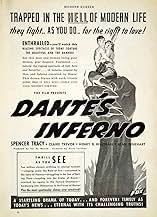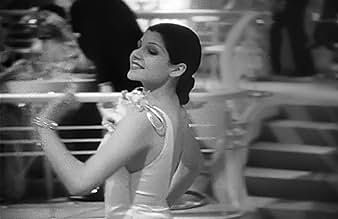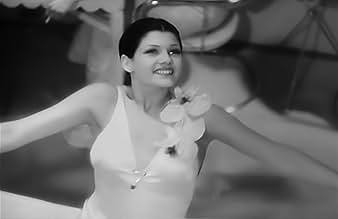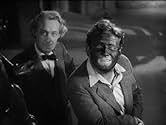Jim Carter moves in on the McWade's carnival concession which shows scenes from Dante's "Inferno". He makes it a going concern, marrying Betty along the way. An inspector calls the amusement... Read allJim Carter moves in on the McWade's carnival concession which shows scenes from Dante's "Inferno". He makes it a going concern, marrying Betty along the way. An inspector calls the amusement pier unsafe but Carter bribes him. The pier collapses, leading to the inspector's suicide... Read allJim Carter moves in on the McWade's carnival concession which shows scenes from Dante's "Inferno". He makes it a going concern, marrying Betty along the way. An inspector calls the amusement pier unsafe but Carter bribes him. The pier collapses, leading to the inspector's suicide, injury to Pop McWade, trial for Carter, and Betty's leaving him. Carter starts over with... Read all
- Awards
- 1 nomination total
- Alexander Carter
- (as Scott Beckett)
- Dancer
- (as Rita Cansino)
- Girl in Stoke-Hold
- (uncredited)
- Man in Stoke-Hold
- (uncredited)
- Mr. Williams
- (uncredited)
- Girl in Stoke-Hold
- (uncredited)
- Concessionaire's Wife
- (uncredited)
- Photographer
- (uncredited)
- Passenger in Boiler Room
- (uncredited)
- Amusement Park Patron
- (uncredited)
Featured reviews
Nothing quite that gaudy here - The central figure (Tracy) begins as a stoker, but slowely rises in the world, frequently not realizing that his greed and drive have alienated friends and relatives. The source of his wealth is the carnival and gambling empire he has put together. In the course of building it he meets Henry Walthall, who wants to build a midway building that shows Dante's Inferno - Walthall believes it will be beneficial to the public as it will show the public the dangerous ice they are on if they continue to sin. Of course this is the screenwriter's take on Dante's Divine Comedy, and the Inferno in particular - actually Dante is far too clever a poet to have such a trivial motive in the actual work for writing it that way.
That Tracy is saved in the end is due to heeding the wisdom of his friend (later his father-in-law)and due to a sea tragedy - Tracy's latest addition to his empire is a gambling ship, which catches fire off the coast of the U.S., and requires Tracy's leadership qualities to save the passengers and crew. A suitable fiery conclusion to the film - and also an historic footnote: the boat is made to resemble the ill-fated Morro Castle, which burned in a fire in 1934 (the year before this film) off the coast of New Jersey, killing 130 passengers and crew. As such, this is the sole movie I know of that refers to that disaster, except for a line of dialogue in the contemporary satiric comedy BOY MEETS GIRL.
Tracy plays a ship stoker and would be con man who gets fired off his ship for malingering. Down on his luck, kindly old Henry B. Walthall who owns a sideshow attraction at a carnival midway takes him in and Walthall's daughter Claire Trevor falls for him.
Spence is nothing if not determined to make something of himself and he becomes a rich man in the amusement game. But his ethics leave a lot to be desired.
The title is not Dante Alighieri's famous poetic saga of his journey through hell, but it's the name of the exhibit that Walthall owns. It's 'educational' but Tracy starts on his road to financial success by glamorizing the more prurient aspects of it.
The Inferno catches fire and there's a climatic ship's fire as well that Cecil B. DeMille could not have staged better. One wishes the film had been in color for that as well as the imaginary ten minute journey through hell that Walthall describes to Tracy.
The dancing team on the ship before the fire marks the screen debut of one Marguerite Carmen Cansino or better known as Rita Hayworth. She was quite the dancer on screen as well as in this person's opinion, the biggest sex symbol the screen ever knew.
Dante's Inferno was a fine film for Tracy to leave Fox with. But it would have astonished the executives at Fox if they could have imagined the career direction it would take at MGM.
The movie's basically a morality tale, showing one man's (Tracy) ruthless climb from bottom to top and learning his lesson after all. I really like the way Carter ingratiates himself socially into the upper class; just having big bucks is not enough. So he uses is well-honed entrepreneurial skills to grease the wheels. And, thanks reviewer Albertsanders for detailing how the story's basis lies in actual fact, surprising as that may seem.
My only complaint is the miracle ending. It sure doesn't comport with the events aboard ship. My guess is that it was a gesture to the newly formed Production Code. Or maybe it was just pandering to what the studio thinks audiences want. Either way, it undercuts a good story and maybe the best special effects of the time.
This film was inspired by (but is not a remake of) a 1924 film with the same title: both films have the same premise but very different plotlines.
We first see Tracy's character Jim Carter on the bottom rung: the Depression is on, and Carter is so desperate he takes a job as a blackface performer. Then he gets a job in a carnival attraction which offers the customers a quick ride through Hell (made of papier-mache).
There's a brilliant performance by Alan Dinehart, one of those great supporting actors from Hollywood's golden age. Dinehart specialised in playing sharp guys on the edge of the law (or slightly beyond it), and this is one of Dinehart's best roles. Henry Walthall, the silent-film star, is also excellent here.
The standout sequence in the film begins when Tracy is in hospital, recovering from injuries. Walthall brings him a copy of Dante's "Inferno", and proceeds to describe the horrible fates awaiting sinners in the afterworld. On screen, we see a series of stark tableaux in which naked men and women suffer eternal torments in Hell ... dodging flames, writhing in chains, turning into trees. For some reason, all the naked people in Hell have gorgeous physiques: apparently Hell doesn't take any chubsters.
"Dante's Inferno" is often mentioned by Rita Hayworth fans, because this movie includes one of her very earliest film roles. (She was still performing as Margarita Cansino, her original name.) Hayworth/Cansino appears very briefly as a ballroom dancer aboard Tracy's gambling ship. This is a standout film, but if you think it's a Rita Hayworth movie you'll be disappointed.
I strongly recommend "Dante's Inferno".
Did you know
- TriviaSpencer Tracy's erratic behavior on this film helped seal his fate with 20th Century-Fox. During filming Tracy disappeared from the set for weeks while on a drunken binge. He reportedly also showed up to the set one day surly and hung over and fell asleep in the "Manhattan apartment" set. The studio locked the stage while he was still asleep; Tracy woke up in a rage and started destroying sets, reportedly causing thousands of dollars worth of damage for which the studio billed him.
- GoofsAll entries contain spoilers
- ConnectionsEdited into Myra Breckinridge (1970)
- SoundtracksThe Wedding March
(1843) (uncredited)
from "A Midsummer Night's Dream, Op.61"
Written by Felix Mendelssohn
Played on a hurdy-gurdy for the wedding photograph
- How long is Dante's Inferno?Powered by Alexa
Details
- Release date
- Country of origin
- Language
- Also known as
- Dante's Inferno
- Filming locations
- Ocean Park Pier, Santa Monica, California, USA(exterior views showing rides including Loop-O-Plane and Chute-the-Chutes)
- Production company
- See more company credits at IMDbPro
Box office
- Budget
- $748,900 (estimated)
- Runtime1 hour 29 minutes
- Aspect ratio
- 1.37 : 1
Contribute to this page







































